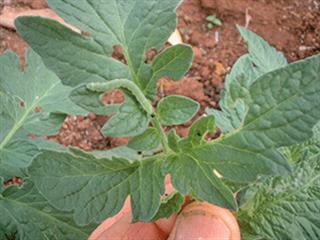
The moths emerge sporadically, when climatic conditions are favourable. Thus there are periods when there’s no sign of them, and you tend to let your guard down – then, suddenly, you find you have a costly outbreak on your hands. My tomatoes grow in plastic tunnels and, at the time of writing, many of the fruit were already 5cm to 8cm in diameter. I haven’t applied any fungicides or insecticides, and have only found one bollworm in each tunnel when breaking off the side-shoots.
Usually at this time there would be hundreds. And that might indeed be the case next year, or even next month. The important thing is not to get caught out and only discover the pest after it has started damaging the fruit. By then, control is far more difficult, as the bollworms chew their way right into the fruit and aren’t exposed to insecticide applications. A single bollworm can also damage a number of fruit.
The first step is knowing when to expect this pest, and commercial pheromone traps will help here. The bait mimics the pheromone the female gives off to attract males. Some traps then gas the moths after they enter, while others have a surface that the moth sticks to. Obviously only males will be caught, but the main purpose of the traps is to determine if the moths are active, and ready yourself for a possible outbreak.
The moths are 20mm to 25mm long and fly at night. They are usually orange or yellowish, and will lay about 700 eggs on very young foliage. The eggs hatch after a few days, and the bollworms are fairly easy to find at this stage. Look for tiny holes in the young leaves and you’ll find the tiny caterpillars, which are dark-coloured and somewhat spiny in appearance. They moult several times and develop into a variety of colours, but always with a lighter band running the length of each side. Very often, the caterpillars are the same green colour as the leaves they feed on.
As they get older they move about, and will be harder to find as they might be some distance from the last place they fed on.
They may start to bore into fruit when still quite young and can damage or consume all the very young fruit on a truss. They often also bore into the stems, and you’ll find a shoot wilting from a certain point, only to discover a hole in the stem where the bollworm entered.
Spray programme
Many farmers use a spray programme to prevent this pest from starting off in the first place. But this can be costly and unnecessary. Furthermore, if you’re not very careful with what you spray, you can cause other pests to flare up which could otherwise have been controlled by natural enemies which the poison has killed.
It’s better to monitor the crop on a regular basis and, using pheromone traps, not get caught unawares. If you discover moths in the traps, look for eggs on the young shoots and spray as soon as they start hatching. This pest is much easier to kill at this stage. And you can use products such as Bacillus thuringiensis, a naturally occurring bacteria, which kills lepidoptera larvae and allows the natural enemies of other pests to continue their good work.
Save later
There are natural enemies of the African bollworm, but they’re not effective enough to achieve complete control. If you use harsh products which are very effective for bollworm control, you could have outbreaks of red spider mite, leaf miner, semi-looper, and others. Rather spend a little more on safe sprays and save later. A spin-off of monitoring the crop closely is that you get to know the crop better and will observe many other useful things, which will make you a more effective farmer.
Contact Bill Kerr at [email protected]. Please state ‘Vegetable production’ in the subject line of your email.












